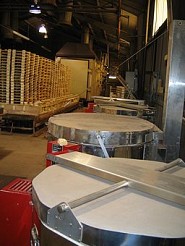Ceramic Tile: How It's Made and What's New
 Ceramic tile is becoming increasingly popular in new home construction, as well as remodels and renovations. Interestingly, this handsome and easy care covering for floors, walls, and backsplashes is still manufactured from all natural raw ingredients, according to an age-old process. However, modern techniques have been developed to imbue ceramic tile with a bold and bright new look for the 21st century.
Ceramic tile is becoming increasingly popular in new home construction, as well as remodels and renovations. Interestingly, this handsome and easy care covering for floors, walls, and backsplashes is still manufactured from all natural raw ingredients, according to an age-old process. However, modern techniques have been developed to imbue ceramic tile with a bold and bright new look for the 21st century.
Manufactured from Traditional All-Natural Ingredients
Fans of green living will be pleased to know that ceramic tile is, and always has been, a completely natural product. The beautiful tile that you install on your floor or backsplash is created mainly out of humble clay, with the addition of mineral ingredients that may include carbonate, feldspar, kaolin, and sand, plus a certain percentage of water to hold it all together. The mixture is blended and ground to produce what is known as the "body slip." It is then dried into a powder composed of uniformly shaped spheres. The powder is placed in molds and compacted with a hydraulic press, resulting in "bisques." This pressing not only forms the tiles into squares, hexagons, ovals, or other decorative shapes, it also strengthens them. They are dried further to get rid of all moisture that may remain.
Glazing and Firing
The next step is an optional glazing process, which will add attractive color and texture. The "green" tile is then heated in a kiln, just like other ceramic products, and may reach a temperature as high as 2,500 degrees Fahrenheit. This firing process used to take several hours, but new conveyor belt-style methods have been developed to speed up the procedure so that the tiles are baked in less than 40 minutes. Nevertheless, tile that is destined for use as flooring is fired a second or third time to toughen it up, often with the addition of another colorful coat of glaze.
Sorting and Rating
The finished tiles are sorted, once again with the help of modern technology. In this case, software is used to recognize irregularly shaped or otherwise inferior tile. Tile that meets the manufacturer's high standards of quality is rated for its hardness according to the criteria of the American Society for Testing and Materials (ASTM), to determine the degree of foot traffic it will be able to handle. The final stage is packing and shipping to suppliers.
What's New in Ceramic Tile This Year
While the basic process has not changed a great deal over the centuries, exciting advances are simplifying tile manufacture while at the same time increasing the design options available to homeowners today. One of the most impressive is high definition inkjet technology. This allows tile to be printed with all kinds of realistic designs.
Some of the more popular tile looks are faux stone and wood; the latter even come in wood-plank shapes and sizes. Textures such as fabric-look and patterns (think chevron or herringbone) are also big, as are metallic. "Stainless steel" and "mineral" continue their wave of popularity, recently joined by gold tile for the kitchen -- now that's glitzy! Imitation oxidized brass lends a lovely patina to any room.
In terms of shape, the once-ubiquitous rectangular subway tile is beginning to be replaced by new styles such as retro hexagons in bright Moroccan colors. These are perfectly suited for another trend -- statement floor tile for kitchen and bath.
And for a quirky touch of humor, pop art and camo style tiles are making a quirky appearance these days. Fancy installing a ceramic tile comic strip on your powder room walls?
Laura Firszt writes for networx.com.
Looking for a Pro? Call us (866) 441-6648

Tile Contractors Experiences

Shower Tile Rehab In Hotel Guest Rooms

A Tile Contractor Ready To Tackle The Whole Job – And Do It Right



